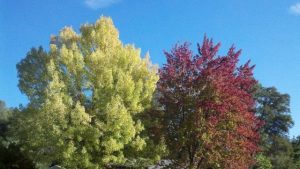Like most Bay Area Transplants, I was confounded by the challenges of Foothill gardening. But the frustrations of heat, drought, and freeze were overcome by the pleasures of the area’s wildlife. Welcoming wildlife into our yards preserves the richness of the Mother Lode. Right now is an ideal time to start, whether you have a three-foot balcony or sprawling acreage! Here’s how:
Plant for Wildlife
Autumn is the best time to plant trees, bushes, and flowering perennial plants since cooler temperatures allow roots to develop before summer’s heat.
If you have native oaks in your yard, treasure them. They are a wildlife bonanza, providing insects, leaves, bark, and acorns for food, plus spreading branches for shelter and nesting. Our native oaks are well adapted to and require summer drought. Do not water under them during the warm months. Avoid compacting the soil under their limbs.
Some native shrubs provide a double payload-spring flowers AND autumn or winter berries for seed eating birds: Manzanita and Ribes (native gooseberries and currents) bloom first, followed by elderberries, coffee berry, snow berry, and toyon.
Autumn sage and California fuchsia (Zauschneria) delight hummingbirds and other pollinators with blossoms until frost.
Put Pesticides Out To Pasture
Six out of ten animal species are insects. Non-discriminate insecticide use kills desirable insects along with the troublesome ones. Insects are needed to attract birds, frogs, and pollinators-bees, flower flies, butterflies, hummingbirds, and bats too.
Pesticide damage can impact the food chain. A case in point is the current alarming decline in bees and other pollinators. Even some “organic” fungicides carry a warning label: TOXIC TO BEES.
Resist the urge to blast insects with a toxic spray. Visit http://www.ipm.ucdavis.edu for less toxic ways to deal with both insect and weed pests.
HOUSEKEEPING CAN HURT.
- Leave leaves and small trimmings lie to form mulch.
- Lawns do little for wildlife. Replace part of your lawn with some of our many attractive native, drought tolerant, and often deer resistant, plants and trees.
- A pond or birdbath will draw all sorts of wildlife.
- Replace fertilizers with homemade or commercial compost or aged barnyard manure.
- A mulching lawnmower reduces the need for lawn fertilizers and can chop leaves for the compost pile.
- Old tree snags can provide a home for cavity dwelling birds.
- A brush pile will be cover for many creatures, including California and mountain quail; after the holidays, add your Christmas tree, pinecones and wreaths (first remove all ornaments, wire, etc.).
Vera Strader grows dozens of hummingbird plants with flowers that also help feed innumerable bees, flower flies, and butterflies.


